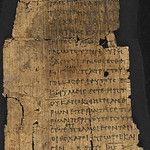
Now you probably aren’t that keen to read a credit agreement between two soldiers to the value of 200 drachmas. But what if they drew up that agreement on papyrus around 2,000 years ago? And that’s not even close to the oldest item in the Papyrus Museum.
- Globally-important collection of valuable papyrus dating back up to 3,000 years
- Also has mummy labels, stelas, and more
- Takes you through over a dozen themed areas
- Look for the book of the dead of Sesostris in particular
- Housed inside the National Library with all display information also in English
- See also:
- Vienna Museums
- Egyptian collection at the Kunsthistorisches Museum
- History exhibitions in Vienna
Special exhibition: A Gift of the Nile. The Power of Water in Ancient Egypt (until May 5th, 2024)…papyrus documents offer insights into management of this critical river resource
Inside the Papyrusmuseum

(Papyrusmuseum; photo © Österreichische Nationalbibliothek/Pichler)
Vienna’s a great place for connections to the past. Mahler’s piano, the Holy Roman Emperor’s crown, Napoleon’s jacket, the bullet-ridden car from Sarajevo, before & after photos of me eating a giant Schnitzel, and so on.
Tucked away below ground in the National Library of Austria, the items in the small Papyrus Museum might seem banal in comparison: a recipe here, a prenuptial contract there. And few famous names in sight.
Yet the worth of the exhibits perhaps exceeds those more celebrity items thanks to the historical importance and age: some of the papyrus sheets are around 3,000 years old.
The museum’s historical theme becomes clear even before you enter the welcome area thanks to the hieroglyphic wall decorations as you approach.
Inside, cabinets and screens present (surprise!) papyrus and related items from various eras of history. An interest in ancient cultures helps, of course, but it’s a humbling experience to wander round.
Many of the texts, written in various languages depending on their age, address the same concerns we have today: credit agreements, letters of complaint, fish orders, medicinal recipes, and even maths exercises.
This commonality across the centuries reminds us of a shared human experience and the ephemeral nature of existence.
That sounds a bit pretentious, so let me put it another way: it’s kind of reassuring to think of Greek students grumbling over their maths homework, too. Needless to say, the Papyrus Museum collection can now be found on UNESCO’s Memory of the World Register.
The museum reopened back in 2021 after a complete refit. Which means a bright setting for the displays, multimedia presentations, and a bilingual experience: all text, audio etc. is also available in English.
The revamped layout takes you on a colour-coded path through themed areas, touching on such topics as magic & medicine, religion, the writing process, private letters, etc.
Experts tend to cite the Egyptian book of the dead of Sesostris from the 15th century BC as the absolute highlight of the collection. You find it right at the start of the museum in the section dealing with funerary cults. I, however, preferred a more literary item…
Xenophon (431 BC to 354 BC) wrote the Hellenica, chronicling “Greek” history from around 411 BC to just before his death.
The Papyrus Museum has the oldest example of the first book of that 7-book series, written around the second and third century AD on the back of a redundant list of land taxes. Wow.

(Papyrusmuseum, Heldenplatz, Neue Burg, 1010 Wien © Österreichische Nationalbibliothek/Pichler)
The museum also contains a few items not made of papyrus. For example, small collections of mummy labels and stelas (essentially gravestones). If that tickles your interest, I can strongly recommend the Egyptian collection at the Kunsthistorisches Museum, too.
The final themed area ranks as another absolute highlight and takes us a little nearer to the present day (but only a little).
Enjoy a reproduction of the famous and fabulous Tabula Peutingeriana: the National Library has the only surviving example of this 13th-century document, itself likely a copy of an illustrated Roman road map(!).
Find Vienna on the Tabula along the top edge just after the middle waterway appears. Look for Vindobona (the Latin name for Vienna).
Tickets & visitor tips
The Papyrus Museum sits in the Neue Burg wing of the Hofburg Palace.
You buy a ticket direct from the service desk at the entrance to the library. At the time of writing, an adult ticket cost €5. The Vienna All-Inclusive Pass from Go City (review) gives you one-time free entry.
As the museum shares space inside the library, many of the latter’s facilities are at your disposal. For example, just inside the entrance is a seating area with machines selling drinks and snacks.
How to get to the Papyrus Museum
See the Neue Burg article for travel tips on reaching the area.
The entrance is slap bang in the middle of the curved part of the building (you can’t miss it). Go in and through the glass doors to the foyer of the library. Once through the ticket barrier head left to find the Papyrus Museum, which is downstairs.
Address: Neue Burg, Heldenplatz, 1010 Vienna | Website